Studies show birds get much of their nutrition from natural sources. Some get less from the feeders we put out. With summer coming, it’s crucial for birdwatchers and pet owners to adjust their bird feeding habits. This change will help keep the birds healthy and happy.
In summer, experts advise changing how you feed birds. This means supporting their normal eating and life patterns. We’ll look at the perks of feeding birds in summer, give advice on keeping feeders clean and safe, and discuss when it’s best to stop feeding them. All to help them live and eat well naturally.
Key Takeaways
- Birds get most of their nutrition from natural food sources, not backyard feeders
- Maintaining clean feeders and bird baths is crucial during hot summer months
- Providing shaded areas and native plants can help birds beat the heat
- Leaving baby birds alone is often the best approach, as parents know how to care for them
- Transitioning feeders for fall migration is important for supporting birds’ natural cycles
The Benefits of Summer Bird Feeding
In summer, longer days and warm weather invite everyone to watch backyard birds. The extra daylight makes it easier to spot birds and see their beautiful breeding colors. This is a perfect time for bird lovers to enjoy watching the unique and colorful birds visit you.
Increased Daylight Hours for Birdwatching
Summer brings longer days, perfect for watching birds up close. You can see hummingbirds whirl through the air or listen to the sweet songs of warblers. This season is full of chances to spot new bird friends and enjoy their antics in your yard.
Easy Bird Identification with Breeding Plumage
What makes summer special for birdwatching is the chance to see birds in their finest outfits. Many birds wear bright, special feathers this time of year. These colors help you figure out which bird is which. It’s like a fashion show for birds!
Observing Nestlings Maturing at Feeders
Summer bird feeding gives you a front-row seat to baby bird drama. As parents bring their young to eat, you can watch them grow and learn. It’s not just fun; it also teaches you about birds’ life cycles. Every day brings a new discovery.
Being a summer bird feeder brings you closer to nature. You’ll love the more birdwatching and the chance to see new life take flight. This season is truly special for all who appreciate the beauty and activity of backyard birds.
“Summer is a time of year when birds are more active, their breeding plumage is at its finest, and their young are learning to navigate the world. Feeding birds during this season can provide a wealth of enjoyment and educational opportunities for nature enthusiasts.”
Maintaining Safe and Healthy Feeders in Summer
When it gets warmer, keeping bird feeders clean and healthy is very important. Summer’s hot and humid weather is perfect for mold to grow. This can lead to the creation of aflatoxin, which is dangerous for birds.
Preventing Mold Growth in Hot Weather
To stop mold, keep feeders half-full and refill them often. This reduces the food turning bad in the heat. Also, put any suet feeders in shady spots. The sun makes the suet too soft and can harm birds’ feathers.
Proper Placement of Suet Feeders
Put suet feeders in shady places like under trees. This keeps the suet from melting and getting sticky. The nutrition in the suet stays good, and the birds enjoy safe eating.
Regular Cleaning and Sanitization
Cleaning and sanitizing your feeders often is key in summer. Every two weeks, wash them with a 10% non-chlorinated bleach mix. This gets rid of bacteria and fungus, making a safe place for birds.
With these steps, you can keep mold away, protect suet in the right spots, and keep feeders clean. This ensures that your bird friends have safe and tasty food all summer.
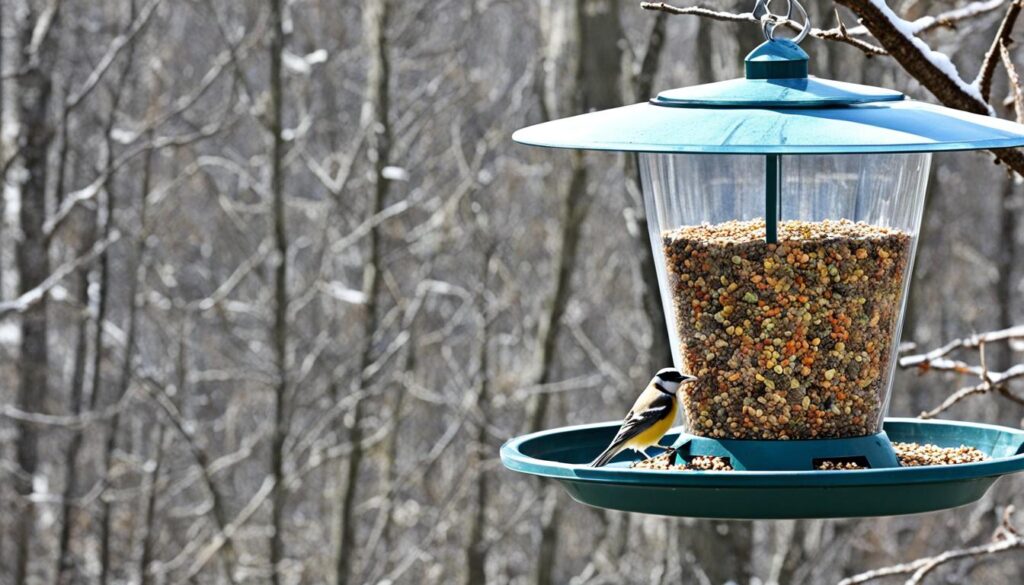
Offering Nutritious Summer Bird Food
As the summer sun beats down, it’s crucial to provide your feathered friends with a variety of nutritious options. This will keep them energized and thriving. Offer the best birdseed varieties for summer, along with fruits and jelly for songbirds, and mealworms and peanuts for insect eaters. Your backyard can become a summer haven for many bird species.
Seed Varieties for Summer Feeding
Birds look for high-energy foods when it’s hot to fuel their lives. Provide a mix of black-oil sunflower seeds, white Proso millet, and nyjer seed to attract many bird types. The soft shells of black-oil sunflower seeds are a favorite. Nyjer seed feeders meet finches’ specialized needs well.
Fruits, Jelly, and Nectar for Songbirds
Add fruits and jelly to your seed mix to delight summer songbirds. Cut fresh oranges, grapes, and watermelon. Or, offer sugar-free fruit jelly for them to enjoy. Fill a nectar feeder with a 1:4 ratio of white sugar to water for hummingbirds. Remember to change this nectar often to prevent spoilage.
Mealworms and Peanuts for Insect Eaters
During nesting season, many birds need mealworms and peanuts for protein. Place these treats in feeders or scatter on the ground. This will attract bluebirds, woodpeckers, and wrens, who love insects.
Don’t forget, offering a diverse menu is key to meeting the dietary needs of your local bird community. Doing so will help them thrive throughout the summer.
Providing Fresh Water Sources
During hot summer months, it’s key to have a reliable source of fresh water for backyard. Birds need water not only for drinking but also for bathing. A proper birdbath can draw in different bird species, making it a lively spot in your yard.
To keep your birdbath inviting, clean it well two to three times each week. You should scrub it with a stiff brush to get rid of any dirt or algae. This keeps the water fresh and free from bacteria, helping to protect the birds.
- Choose a birdbath with a shallow depth, ideally no more than 2-3 inches, to accommodate both small and large bird species.
- Position the birdbath in a sheltered, shaded area to protect it from direct sunlight and minimize algae growth.
- Consider adding a recirculating pump or dripper to keep the water constantly moving, which helps deter mosquitoes and maintain freshness.
- Refill the birdbath daily, ensuring there is always a sufficient supply of clean, cool water for your backyard birds.
By offering a reliable fresh water source for backyard birds, you’re boosting their health and happiness, especially in summer. This step is simple but crucial for welcoming more birds to your yard and supporting them.
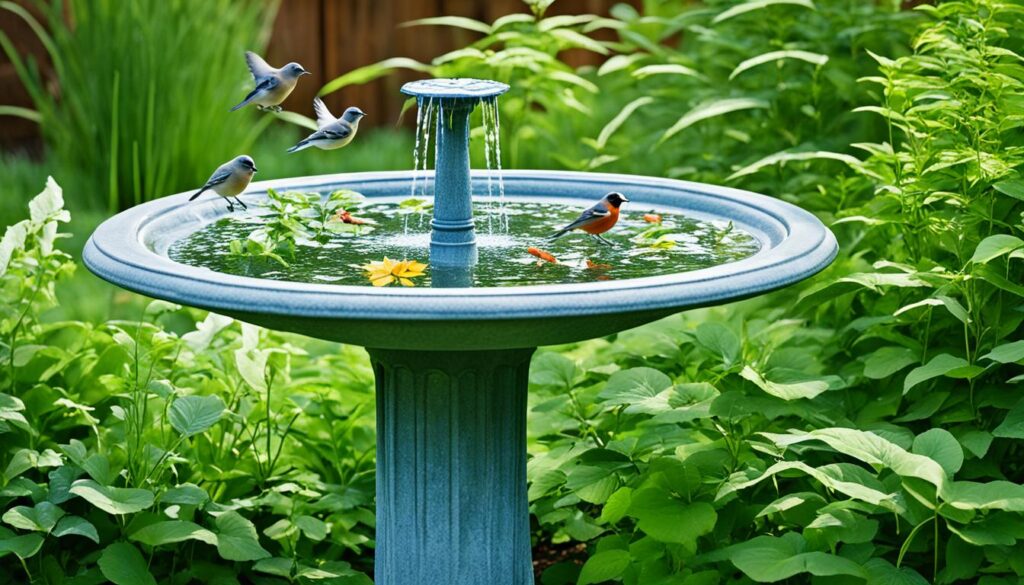
“Offering a clean, reliable water source is one of the most important things you can do to support your backyard birds in the summer.”
| Birdbath Feature | Benefit |
|---|---|
| Shallow depth (2-3 inches) | Accommodates birds of all sizes |
| Shaded placement | Prevents algae growth and keeps water cool |
| Recirculating pump or dripper | Deters mosquitoes and maintains freshness |
| Daily refilling | Ensures a constant supply of clean water |
Creating Shady Respites in Your Yard
During the summer, birds need shady spots to hide. Using creating shade for backyard birds helps. You can make cool, shady places by planting native trees and bushes. These offer a nice break from the hot sun.
Tiered Landscaping with Native Plants
Local plants love the hot weather and don’t need much work. Planting them in levels gives birds cool places to rest. Make sure to choose plants of various sizes. This helps birds find their ideal spots and keeps your yard cool with natural shades.
Placing Feeders in Shaded Areas
Put your bird feeders in the shade to help your bird buddies. This way, they can eat without the sun in their eyes. Such an easy move can keep birds happy and coming back to your yard.
Proper Ventilation for Bird Houses
Don’t forget about your bird houses. Good ventilation is key for nesting birds during summer. Holes for air help keep the houses from getting too hot. It’s a small but critical step to look after your bird guests.
With these steps, you can make your yard a cool, friendly space for birds. Planting right, putting feeders in shady spots, and keeping bird houses ventilated all help. You’ll enjoy watching and helping your flying visitors thrive.
“Creating a shaded oasis in your yard not only benefits the birds, but it also enhances the overall aesthetic appeal of your outdoor space.”
when to stop feeding birds in summer
Summer makes bird lovers question when to pause feeding backyard birds. Contrary to common belief, birds won’t rely too much on feeders if fed in summer. Yet, it’s clear from studies that birds mainly get a small part of their food from feeders, maybe less for certain types.
Nearly 60% of bird feeders in the U.S. stop putting out food in summer. This trend is highest in June and July when natural food is abundant for birds.
- The point at which to stop feeding in summer varies by region due to different climates and habitats. Southern states might keep feeding longer compared to the Northeast.
- Bird watchers are more engaged in conversations about summer feeding practices now. They try to meet bird needs while following what’s best for the season.
- Most bird species can find their food during summer. Insects, berries, and seeds are plentiful, helping them stay independent from feeders.
Yet, each bird type may need different feeding care in the summer. For example, hummingbirds will not abandon nectar feeders even in the summer. But, other birds might use feeders less as the season changes.
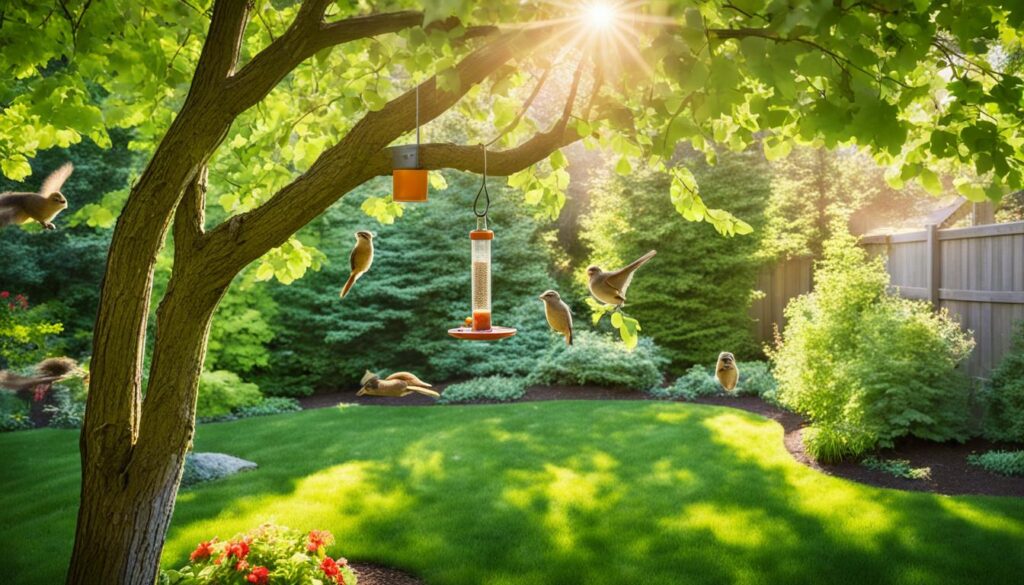
“Feeding birds can help them through hard times. Still, aligning our feeding with nature is key.”
Deciding when to quit summer bird feeding involves several factors. Think about the kinds of birds near you, their food sources, and how your choices impact their lives. Finding the right mix helps your birds survive and flourish during the summer and beyond.
Letting Nature Take Its Course
In many suburban areas, homeowners work hard on their lawns. They mow and trim their yards all the time. But during the summer, it’s a good idea to let nature do its thing in some parts of your yard. Letting native plants and grasses grow freely can help birds find more food and shelter when it’s hot.
Allowing Native Plants to Grow Wild
Don’t cut back bushes and let the plants and grasses grow on their own. This step of letting native plants grow wild makes your yard a better place for birds. It also helps the local ecosystem. Native plants offer different seeds, berries, and bugs that birds depend on in summer. This is crucial since bird feeders might not be enough during this time.
Avoiding Disturbance to Nesting Birds
In summer, watch out for nesting birds. It’s best not to bother them. This way, your yard can be a safe place for birds to raise their young. Try to avoid too much mowing or pruning near nest boxes or active nests. This keeps everything calm and safe for the birds.
“Letting nature take its course in your backyard not only benefits the birds, but it also creates a more sustainable and visually appealing outdoor space.”
Taking a hands-off approach with your yard in summer is a good idea. It supports the natural bird life where you live. By doing a bit less, you help birds find what they need to do well. It’s a simple way to make your yard a better place for these flying creatures.
Leaving Baby Birds Alone
During summer, we might find baby birds outside their nests. Our first thought could be to help them. But most of the time, it’s better to let them be. This is because their parents are probably nearby, ready to help.
If a baby bird is on the ground, start by watching from afar. Check to see if the parents are still caring for it. They might be nearby, bringing food, or watching over their baby. Unless it looks hurt or in immediate danger, it’s wise to let it stay there.
- Nestlings may be on the ground temporarily as part of the natural fledging process, where they learn to fly and become independent.
- The parents will continue to feed and care for the baby even when it’s out of the nest.
- Removing the nestling from its environment can disrupt the normal parental care and lead to the baby’s demise.
Only intervene if the baby bird seems hurt or in trouble. Then, reach out to a wildlife care center or local experts. They can check the bird and offer help if needed.
Leaving baby birds alone, unless they are clearly injured or in immediate danger, is the best way to ensure their well-being and successful transition to independence.
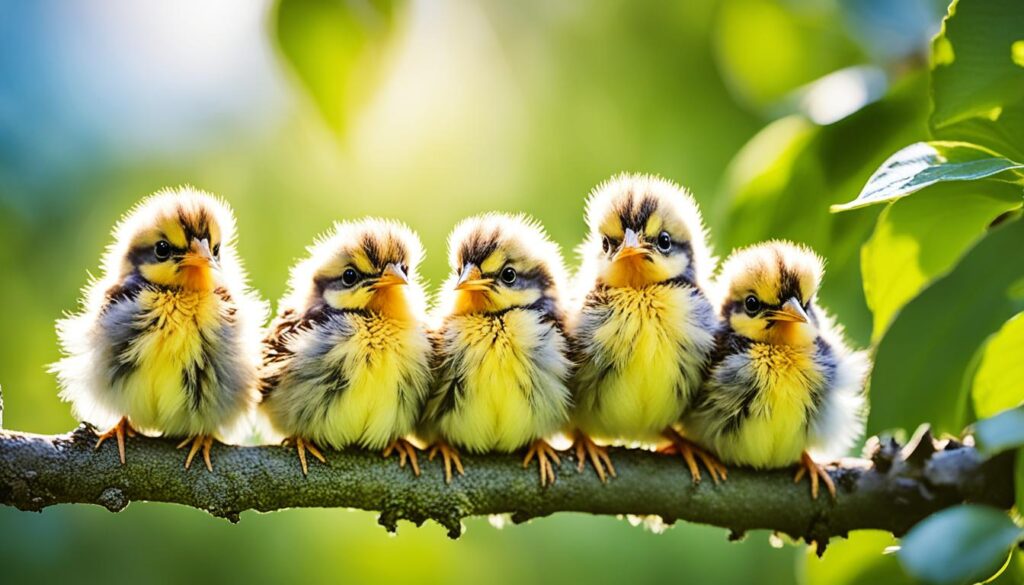
“The best way to help a baby bird is to leave it alone and let nature take its course.”
By letting nature play out, we support the young birds’ growth. With a bit of patience and understanding, we can witness nature’s beauty up close.
Seasonal Changes in Bird Populations
As seasons shift, different bird species visit our backyards. Across North America, summer welcomes new feathered friends not seen in the winter. Learning about these summer birds can make birdwatching more exciting and deepen our bond with nature.
Summer Bird Species in Your Area
During summer, you might see some common summer bird species in your yard. This includes:
- Hummingbirds, like the Ruby-throated Hummingbird, are attracted to flowers and hummingbird feeders for nectar.
- Orioles, with their bright orange and black colors, enjoy juices, jelly, and nectar.
- Rose-breasted Grosbeaks, with their colorful appearance, are a joy to see.
- Indigo Buntings, showing off their dazzling blue against foliage.
- Baltimore Orioles, symbolizing the start of summer with their colors.
More bird species will likely visit as daylight increases and it gets warmer. Watching the seasonal changes in backyard bird populations is rewarding during summer.
| Common Summer Bird Species | Distinguishing Features | Typical Feeding Behaviors |
|---|---|---|
| Ruby-throated Hummingbird | Iridescent green back, ruby-red throat patch | Hovers at feeders and flowers to sip nectar |
| Baltimore Oriole | Bright orange body, black head and back | Feeds on fruit, jelly, and nectar at feeders |
| Rose-breasted Grosbeak | White body with black head and wings, rose-red chest | Eats seeds, fruits, and insects at feeders and in trees |
| Indigo Bunting | Vibrant blue plumage, small conical beak | Forages for seeds, insects, and berries on the ground and in shrubs |
Knowing about the seasonal changes in backyard bird populations and the common summer bird species near you can make birdwatching better. It also connects you more deeply with the natural world.
Supplemental Feeding vs Natural Foods
In summer, there’s a wide discussion on what’s best for birds: feeding them from our yards or letting them find food naturally. Chances are you enjoy watching them when you put out bird food. But, experts don’t all agree on the effects this might have in the long run.
We should make sure the food we offer is safe for wild animals. Supplemental feeding might be useful for the birds near you. Yet, it could mess up their usual routes and population sizes. Natural foods from plants they’re used to are better because they have what the birds really need.
Insects are big on the menu when it’s warmer, which means birds go for them more than the feed we put out. It’s fascinating because more birds show up to eat when they’re moving to new areas. That’s when you might see different bird types, like Rose-breasted Grosbeaks.
It’s cool to note that adult birds sometimes bring their young to learn how to use the feeders. This time allows you to witness adult and young birds hanging out together. But, it’s crucial to take the feeders down if the birds are sick. This move helps to keep illnesses from spreading to other birds.
“Supplemental feeding can help individual birds in your neighborhood, especially if plentiful native plants aren’t available.”
If you’re thinking of feeding birds in your yard this summer, think it through. It’s nice to watch and can be fun. But, it could change how birds live and find their food. Instead of just putting out food, focusing on creating a natural spot with the right plants is better. It helps to support the health of the local birds over time.

Responsible Summer Bird Feeding Practices
With the arrival of hot summer days, caring for our feathered friends is crucial. It’s nice to feed them, but we must do it right. This ensures a healthy yard for both birds and people. Let’s look at how to feed birds properly during summer.
Moderation and Portion Control
Feeding birds in summer means giving just enough food. Offer only what they can eat in a day or two. This stops food from going bad and pests from coming. Too much food in the feeders can mean wasted food with mold and harmful bacteria. Choose the right seeds for summer, and watch how much you give to keep their diet good.
Monitoring for Avian Diseases
Watching out for illnesses is key, especially during summer. Birds can pick up diseases if feeders are dirty. Check your feeders for any sign of mold or if birds act strange. Clean them with a bleach and water mix to keep things safe. This step is vital in stopping diseases like salmonellosis, a big danger for birds such as Pine Siskins and American Goldfinches.
Using special antimicrobial feeders, like Wild Birds Unlimited EcoClean® Feeders, adds more protection. These feeders can help stop diseases from spreading. These actions create a safer space for the birds we enjoy in our yards.
Remember, summer bird feeding is about more than just feeding. It’s also about keeping our bird friends safe. Being careful with the amount and type of food, as well as how clean feeders are, keeps them healthy. So, let’s enjoy feeding birds this summer while looking after their health.
Transitioning Feeders for Fall Migration
With the change in seasons, the supply of natural bird food will lessen. It’s time to adjust your feeders to help migratory birds. The fall migration is vital for many birds. Your backyard can be a key stop on their travels.
Choosing the right food is crucial. Birds need high-energy foods for their long flights. Sunflower seeds and Nyjer seed are great because of their fats and calories.
- Peanuts and peanut butter are also rich in fats and calories, making them beneficial for woodpeckers, jays, and nuthatches.
- Suet, a high-fat food, is ideal for autumn birds such as woodpeckers, titmice, wrens, and chickadees.
- Cracked corn is a hearty carbohydrate source suitable for ground-feeding birds in autumn.
- Don’t forget nectar for hummingbirds and orioles. Keep it from freezing as autumn gets colder.
Consider the right spot for your feeders as well. With more birds gathering, they need space. Ensure there’s enough room for them to feed comfortably.
By adjusting your feeders for the fall, your home can be a welcoming stop for migrating birds. This helps these birds gain energy for their trips.
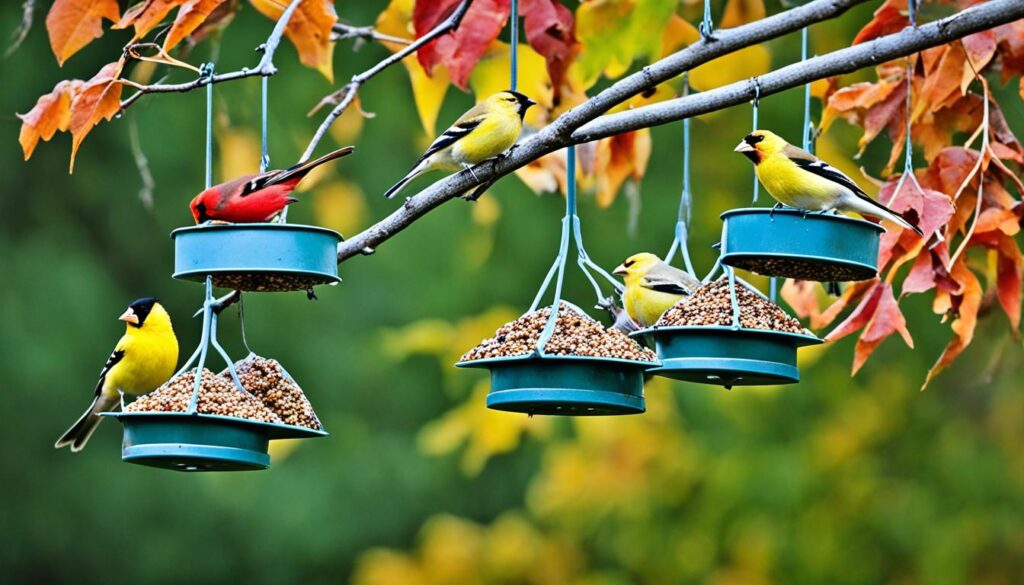
“Many jays, woodpeckers, nuthatches, chickadees, and titmice will begin caching food in autumn, preparing for the winter months ahead.”
Keep a steady feeding schedule for the fall. This can greatly help the birds. By knowing what birds need, we can turn our spaces into bird-friendly habitats. This supports their journey and health.
Conclusion
Feeding birds in summer benefits both birds and birdwatchers. By taking care of your feeders, choosing the right foods, and making a safe spot, you’re doing a great thing. Offer a mix of seeds, fruits, and mealworms for different birds. Also, keep water fresh and avoid mold in your feeders. Including native plants in your yard brings more bird species. It’s a way to create a lively space for birds all season.
It’s important not to feed birds too much, so they still find their own food. But, a little help in summer, when food is hard to find, is good. With careful feeding, you help birds and enjoy watching them. It’s about finding a good balance.
In fall and winter, your bird feeding should change. Migratory and local birds need different things then. By adjusting what you offer, your yard stays bird-friendly. This helps you love and understand birds all year round.
FAQ
Is it necessary to stop feeding birds during the summer?
No, you don’t need to stop. Both the U.S. Fish and Wildlife Service and the Cornell Lab say it’s good to feed birds all year. It helps the birds and their populations.
What changes should I make to my bird feeders in the summer?
It’s crucial to avoid mold in the summer. Fill feeders halfway and refresh them often. Put suet feeders in the shade. Clean your feeders every two weeks to prevent mold.
What types of food should I provide for birds in the summer?
Along with seeds, try fruits, jelly, nectar, mealworms, and peanuts for summer birds. Skip bread and peanut butter—they don’t offer much nutrition.
How can I create a bird-friendly environment in my yard during the summer?
Keep water fresh for birds to drink and bathe. Use native plants for shade. Place your feeders in shady spots and maintain airflow in birdhouses.
What should I do if I find a baby bird out of its nest in the summer?
If the baby bird looks healthy, leave it be. Its parents are probably looking after it. Just help injured birds by contacting a wildlife rehab center.
How can I support birds during the summer without using feeders?
Encourage your yard’s natural growth. Native plants offer food and shelter. This choice won’t disturb bird nests.
When should I start preparing my feeders for the fall migration?
Get ready for fall bird migration as summer ends. Change feeder food types and make sure your feeders are clean and ready.


Hola! I’ve been reading your web site for a long time now and finally got
the bravery to go ahead and give you a shout out from Huffman Tx!
Just wanted to mention keep up the good work!
Here is my blog – nordvpn coupons inspiresensation (http://ur.link/nordvpn-coupons-inspiresensation–83138)
350fairfax nordvpn code
Yes! Finally something about nordvpn special coupon code.